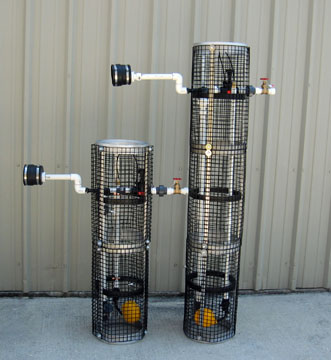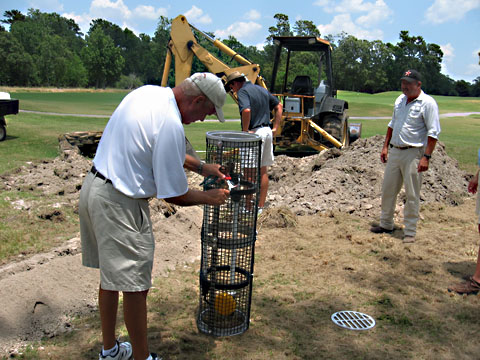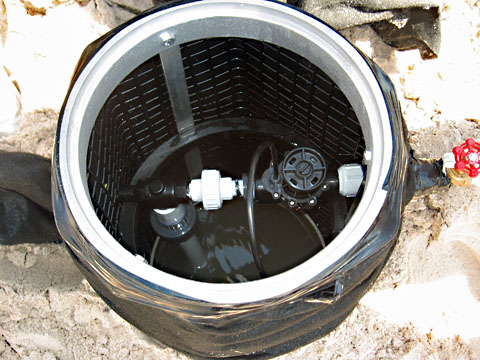TDA MINIATURIZES ELECTRICITY-FREE PUMPS
TDA received patent pending status on its new Mini IDP3. The new Mini IDP makes electrical free technology smaller. The larger versions have been used to replace 1 to 3-hp pumps in drainage sumps using the energy from the irrigation system to pump drainage water. The newest version is available in a package with TDA’s patented Perma Basins, and can be used anywhere on the course.

The applications are endless. David Steel, National Project Director for TDA, says that this is ideal for courses that stay wet because there is too little elevation change between their fairway and lake reliefs. The system is easy to install in-house. The superintendent can go into a wet area, replace a basin that is too shallow to achieve the firmness the club desires, and replace the basin with one  that will drain three to six feet deep. The key though, is that the superintendent can use the existing outfall pipe as the relief. The mini will lift the water up to the existing outfall without the need to run electrical service to the site. All that is required is a connection to an irrigation lateral line to drive the Mini IDP. 
Steel says we have designed projects where the savings have been huge. We know from the hundreds of drainage systems we have designed that the deeper the relief point, the less seepage drainage is needed to achieve the desired results.

TPC SOUTHWIND USES TARP SYSTEM ON IN-HOUSE DRAINAGE PROJECT
Jim Thomas, CGCS at TPC Southwind, purchased the Turf Drain Tarp System prior to tackling an in-house drainage project this spring. Jim hosts the St. Jude Classic presented by Fed Ex on the PGA Tour every June.
The tarp system saves 80% of labor needed to move the spoils, compared to using plywood and utility vehicles. In addition, the damage to the course during the project is drastically reduced, and allows him to get his course back into shape for the June tour stop. The Turf Drain Tarp System has been used by contractors on some of the finest courses in the country, and is available to golf courses for in-house projects.
Jim says, “The system can be easily learned in just a few days, and once the crew uses it, we won’t ever go back to the old-fashioned way of moving spoils.”
The system can be easily learned…we won’t ever go back to the old-fashioned way of moving spoils.
SEQUOIA GREENSCAPES RENOVATES BUNKERS
Sequoia Greenscapes is in the process of renovating bunkers on 7 golf courses in the Houston area, including 4 golf courses at The Woodlands, Texas, home of the Administaff Small Business Classic on the Champions Tour. The project is headed up by Mike Archer. Mike and his staff have over 20 years of golf course construction experience, and do everything from new construction to small renovation projects.
Mike says, “We have taken several different bunker methods and combined them into one system that will extend the life of bunkers for minimal costs. For a completed cost lower than the material cost alone of some other methods, we are achieving the objectives golf courses are looking for in their bunker projects. We have reduced the erosion off of the faces by over 90%, including the heavy thunderstorms we receive here on the Gulf Coast. Some of these bunkers have been in for almost two years, and during a recent 6″ rain, our repair time was minimal on all of the completed bunkers. In addition, we stabilized the sub-grades with cement and we have eliminated gravel in the drainage design. The Turf Drain and Perma Basins from TDA have worked great.”
The Turf Drain and Perma Basins from TDA have worked great.
The process involves removing a portion of the old sand and leaving some to inter-mix with the roto-tilled cement and sub-grade. Next, we install the drainage. We have many steeply sloped bunker faces here and the key to the success has been the addition of an erosion control line at the toe of the slope. By using Turf Drain without gravel, we can stop the movement of the water along the sub-grade that causes the sand to erode, without fear of gravel contaminating the playing surface. You can contact Mike for quotes on bunker projects at Sequoia Greenscapes at 713-501-7456.
 DRIVE OVER RUBBER CURBING EASY AND EFFECTIVE
Drive over rubber curbing can be used by courses to change sheet flow that is coming across cart paths into stream flow that can be easily collected by a single drainage basin. Wide sheet flows can make a mess of fairway areas.
With the Turf Drain Drive Over Rubber Curbing, superintendents can inexpensively direct this water to a single basin without interfering with normal cart path traffic patterns. The curbing can be crossed by the golfer with hardly a notice, yet it is effective enough to direct thousands of gallons of water to a well placed inlet. The curbing is inexpensive and can be installed with a standard caulking gun.
TECH SECTION:
Particle sizing – Why gravel should not be used in fairway drainage
At Turf Drainage Co. of America, we strive to meet proper seepage and drainage principles in all aspects of our drainage installations. That is why we have always advised against the use of gravel in fairway drainage installations. Superintendents find that the easiest way to relate to this is to compare it to the way they do greens’ drainage.
When greens’ mixes are sent into a certified USGA lab to test their ability to bridge with the gravel, the lab is trying to determine if the 15th largest particle in the mix will be held in place by the voids created by the gravel. As we all know, the particles that make up greens mixes are huge when compared to the particles that make up the native soils on most golf courses.
This can easily be tested at your course. Just send in a sample of your fairway soils to be drained, along with the gravel to a USGA certified lab, and let them check your native soil’s ability to bridge. You will quickly find out that over 95% of all fairway soils will fail. If it does fail, the correct solution is to use a properly sized sand as the backfill material. Let the designers at TDA show you how you can build a technically correct system at your course.

